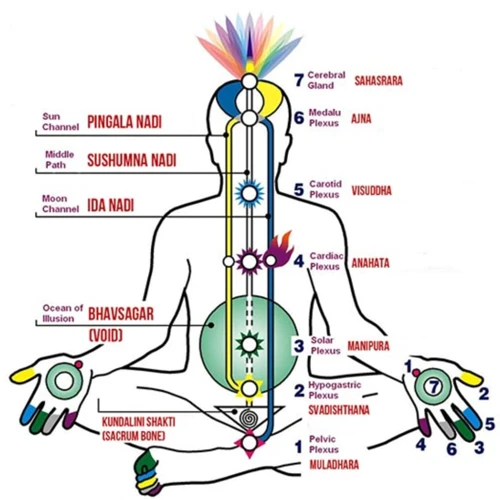As we navigate through life, it’s easy to become overwhelmed and lose touch with our inner selves. But what if there was a way to unlock a power within us that could help us connect with our true selves and find balance? Enter Kundalini and chakras – two ancient practices that have been utilized for centuries to enhance physical, mental, and spiritual well-being. The concept of chakras refers to energy centers within the body that correspond to different physical and emotional states, while Kundalini is the dormant energy coiled up at the base of the spine that can be awakened and harnessed for personal growth. In this article, we’ll explore the world of Kundalini and chakras, how they work, and the benefits of incorporating these practices into your life.
What are Chakras?
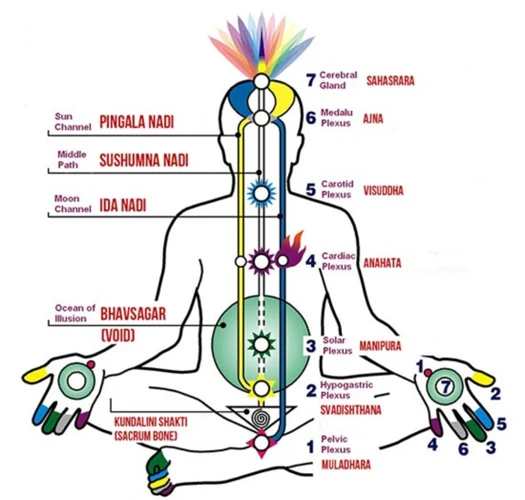
Have you ever heard of the term “chakra”? It’s a word that’s often used in spiritual and wellness circles, but the meaning and significance behind it may not be immediately clear. Essentially, chakras are energy centers within the human body that are believed to correspond with various physical, emotional, and spiritual aspects of our being. Each of the 7 chakras has its own unique qualities and functions, and understanding them can help us gain deeper insight into ourselves and our overall well-being. Let’s explore the fascinating world of chakras together.
The 7 Chakras
There are seven main chakras located within the body, each with its own unique properties and functions. The Root Chakra, also known as the Muladhara, is located at the base of the spine and is associated with our sense of security and stability. The Sacral Chakra, or Svadhisthana, is located in the pelvic area and is connected to our creativity and sexual energy. The Solar Plexus Chakra is located in the abdomen and is responsible for our sense of personal power and self-esteem. This chakra is also known as the Manipura.
Moving up the body, we come to the Heart Chakra, also known as the Anahata, which is located in the center of the chest and is associated with love, compassion, and emotional well-being. The Throat Chakra, or Vishuddha, is located in the throat and governs our ability to express ourselves clearly and effectively. The Third Eye Chakra, or Ajna, is located in the forehead and is associated with intuition, wisdom, and insight. Finally, at the top of the head, we have the Crown Chakra, or Sahasrara, which is connected to our spiritual awareness and sense of unity with the universe.
Each chakra is said to be connected to a different aspect of our physical, emotional, and spiritual well-being, and balancing these energy centers is believed to promote overall health and well-being. Practitioners of Kundalini and chakra work may use various techniques, such as meditation, yoga, and energy healing, to help balance and activate these chakras and unlock their full potential.
What Do They Do?
Chakras are powerful energy centers within the body that play a crucial role in our overall health and well-being. Each of the 7 chakras is responsible for specific physical, emotional, and mental functions, and when these chakras are balanced and aligned, we experience optimal health and vitality.
Here’s a breakdown of each chakra and what it governs:
| Chakra | Location | Governs |
|---|---|---|
| Root | Base of the spine | Survival, grounding, physical needs |
| Sacral | Lower abdomen | Emotions, creativity, sexuality |
| Solar Plexus | Above the navel | Personal power, confidence, self-esteem |
| Heart | Center of chest | Love, connection, compassion |
| Throat | Throat area | Communication, self-expression, truth |
| Third Eye | Center of forehead | Intuition, insight, spirituality |
| Crown | Top of head | Higher consciousness, connection to the divine |
When these chakras become blocked or unbalanced, various physical and emotional issues can arise. For example, if the throat chakra is blocked, we may struggle with expressing ourselves or communicating effectively. If the solar plexus chakra is imbalanced, we may experience low self-esteem or a lack of personal power.
By understanding the role of each chakra and how it affects us, we can work to bring them into balance through various practices such as meditation, yoga, and breathwork. The result is a more harmonious and fulfilling life where we can tap into our full potential and power.
What is Kundalini?
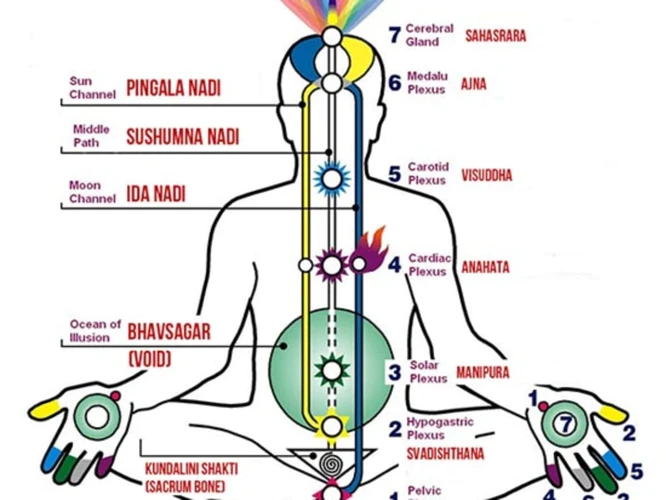
The concept of Kundalini is often surrounded by mystery and intrigue. It’s a term used in yoga and other spiritual practices to describe an intangible force that lies dormant at the base of the spine. When awakened, Kundalini is said to flow up through the body and unlock incredible power and potential within us. But what exactly is Kundalini, and how does it work? Let’s explore this fascinating topic together.
Definition and Origin
Kundalini is a Sanskrit term that means “coiled.” It is believed to be a primal energy that is coiled at the base of the spine. The concept of kundalini can be found in various Eastern spiritual traditions, including Hinduism, Buddhism, and Jainism.
Origin of Kundalini
The origins of the concept of Kundalini are not entirely clear. It is believed that the concept can be traced back to ancient India, where it was first mentioned in the Upanishads, which are ancient Hindu texts. The Upanishads describe Kundalini as a dormant energy that lies at the base of the spine, waiting to be awakened.
Definition of Kundalini
Kundalini is often described as a powerful serpent energy that lies dormant at the base of the spine. When awakened, this energy rises up through the chakras, enlivening and rejuvenating the entire body.
According to the Kundalini yoga tradition, the awakening of Kundalini can bring about profound spiritual transformation and enlightenment. The awakened Kundalini is believed to open the doors to higher states of consciousness and greater awareness of the self.
While the concept of Kundalini can be found in various spiritual traditions, it is most commonly associated with the practice of Kundalini Yoga, which aims to awaken and activate this dormant energy within the body.
Benefits of Kundalini
The awakened Kundalini is believed to bring about a range of benefits, including increased creativity, heightened intuition and awareness, and greater physical and emotional well-being. However, it is important to note that the Kundalini awakening process can be intense and should be approached with caution and proper guidance.
How Does Kundalini Work?
The process by which Kundalini works can be difficult to understand due to its abstraction and multidimensionality. Nevertheless, it is essential to have a basic understanding before beginning the practice of Kundalini awakening.
Here are some key points to help you understand how Kundalini works:
- According to the traditional view of Kundalini, it is an energy that is present within all of us, coiled up like a serpent at the base of the spine.
- This energy needs to be awakened and allowed to move upwards through the chakras along the spine to activate spiritual potential.
- The movement of Kundalini energy is said to be facilitated by various yogic practices and meditation techniques.
- As the Kundalini energy moves through the chakras, it purifies and balances the chakras, leading to heightened states of awareness.
- Each chakra has its unique qualities, and as Kundalini energy flows through them, these qualities become more dominant in the practitioner’s life.
- However, Kundalini awakening can be intense and even dangerous if not approached with utmost care and caution.
It is essential to prepare the body and mind before attempting to raise Kundalini energy through yogic practices and meditation techniques.
Some preparatory practices for awakening Kundalini include:
- Deep breathing exercises to calm and prepare the mind
- Body purification techniques
- Regular asana practice (yoga postures) to strengthen the body and open the energy channels
- Daily meditation practice to still the mind and develop focus
It is crucial to approach Kundalini awakening with the guidance of an experienced teacher to ensure safety and avoid potential risks.
Ultimately, Kundalini awakening is a process of profound spiritual transformation that can lead to self-realization and heightened states of consciousness. Knowing how Kundalini works and preparing both the mind and the body can help facilitate this process safely and effectively.
Awakening Kundalini
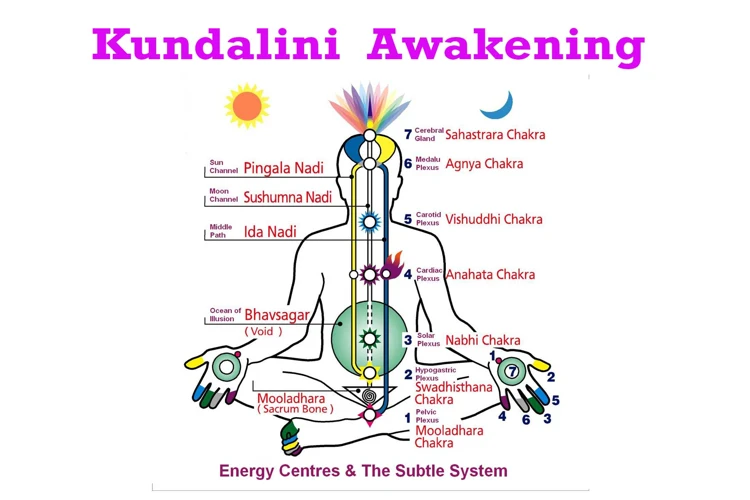
Unlocking the power within ourselves is a deeply transformative journey that requires courage, persistence, and awareness. One way to access this power is through awakening the Kundalini, a powerful energy that lies dormant at the base of our spine. The process of awakening Kundalini is both mysterious and fascinating, and it can bring profound changes to our physical, mental, and spiritual well-being. However, it’s important to approach this process with caution and preparation to ensure that we can fully navigate its challenges and reap its benefits. Let’s explore the fascinating journey of Kundalini awakening and learn how to prepare for its powerful awakening.
Signs and Symptoms
When the Kundalini energy begins to awaken, it can have various signs and symptoms. It’s important to understand that these experiences can vary from person to person and may not necessarily occur in a linear order. Here are some common signs and symptoms:
| Signs | Symptoms |
|---|---|
| 1. Energy sensations: | A rush of energy might travel up and down the body or through specific chakras. You might feel sensations of heat or cold, vibration, or tingling sensations. |
| 2. Physical sensations: | You might experience shaking, twitching, or itching. Unusual sensations in the body might arise, such as new pain or pressure, especially in the areas around the spine or head. |
| 3. Emotional imbalances: | You might experience mood swings, anxiety, or depression. Past trauma might resurface, and you may need to work through it with the help of a therapist or energy healer. |
| 4. Heightened intuition: | You may find that your intuition and psychic abilities become stronger. You may experience vivid dreams, premonitions, or a greater sense of awareness about yourself and the world around you. |
| 5. Spiritual experiences: | You may have profound spiritual experiences, such as feeling a connection to a higher power, encountering spiritual beings, or having a mystical experience of oneness with the universe. |
It’s important to keep in mind that these symptoms can also be a sign of other health issues, so it’s always a good idea to consult with a healthcare professional if you experience any persistent or problematic signs or symptoms. Additionally, it’s important to practice mindfulness and self-care in order to support your body and mind during this transformative process.
Preparation and Safety
Before attempting to awaken Kundalini and work with the Chakras, it is important to take the necessary precautions to ensure your safety and wellbeing.
Preparation
One of the most important aspects of preparing for Kundalini awakening and Chakra work is choosing a qualified teacher or mentor who can guide you through the process. This person should have extensive knowledge and experience in Kundalini and Chakra work and be able to provide you with personalized guidance and support.
It is also essential to have a strong personal practice, such as daily meditation and yoga, to help prepare your body and mind for the intensity of Kundalini awakening. This practice will also help you develop self-awareness and cultivate the necessary inner strength and resilience for the journey ahead.
Safety
Working with Kundalini energy can be intense and potentially dangerous if not approached with caution and respect. It is important to listen to your body and pay attention to any signs of discomfort or distress.
Some potential risks of working with Kundalini energy include physical and emotional side effects, such as headaches, nausea, anxiety, and mood swings. These side effects can be minimized by working slowly and gradually, and by taking breaks when needed.
Additionally, it is important to maintain a healthy lifestyle, such as eating a balanced diet, getting adequate sleep, and avoiding drugs and alcohol, to support your physical and emotional wellbeing.
Summary
Preparing for Kundalini awakening and Chakra work involves finding a qualified mentor, developing a strong personal practice, and taking the necessary safety precautions, such as listening to your body and maintaining a healthy lifestyle. By approaching the process with caution and respect, you can work with Kundalini energy in a safe and meaningful way.
Science Behind Kundalini
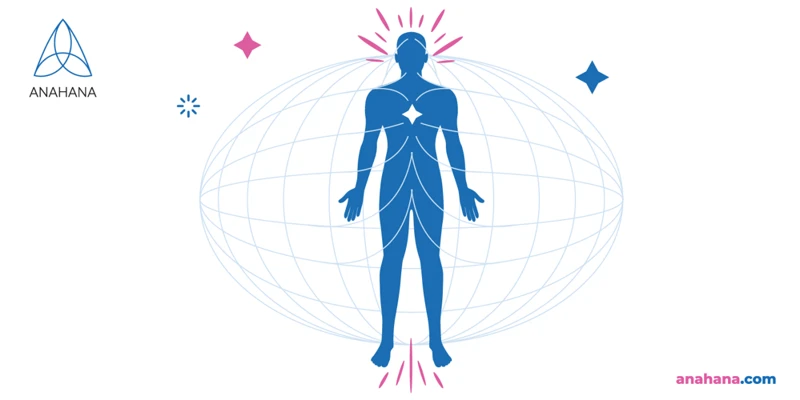
Many people often associate Kundalini and Chakras with spiritual or mystical beliefs. However, there is also scientific evidence supporting the existence and benefits of these practices. Understanding the science behind Kundalini and Chakras can help individuals validate their experiences and provide a clearer understanding of how these practices work. Through exploring the connection between the brain, nervous system, and energy fields within the body, we can gain insight into the physical, mental, and emotional benefits of Kundalini and Chakra work. Let’s delve into this fascinating topic and explore the scientific basis of these practices.
Brain and Nervous System
The brain and nervous system play a crucial role in understanding the science behind Kundalini. When awakened, Kundalini energy moves through the spine and activates the nervous system. This can lead to increased activity in the brain, specifically the area responsible for spiritual experiences – the prefrontal cortex.
Here are some key ways that Kundalini awakening affects the brain and nervous system:
- Activation of the Sympathetic Nervous System: Kundalini awakening can activate the sympathetic nervous system, which is responsible for the body’s “fight or flight” response. This can cause physical symptoms such as increased heart rate, sweating, and trembling.
- Stimulation of the Endocrine System: Kundalini awakening can also stimulate the endocrine system, which is responsible for the production and release of hormones. This can lead to heightened emotional experiences and increased energy levels.
- Increased Blood Flow to the Brain: As Kundalini energy moves up the spine, it brings increased blood flow to the brain. This can result in heightened awareness, clarity of thought, and improved cognitive function.
- Activation of the Pineal Gland: Kundalini awakening can also activate the pineal gland, which is responsible for producing the hormone melatonin. This can lead to improved sleep and feelings of relaxation and calmness.
- Opening of the Third Eye: The third eye is a metaphysical concept that is often associated with increased intuition and spiritual awareness. Kundalini awakening is said to open the third eye, leading to heightened spiritual experiences and a deeper connection to the divine.
Kundalini awakening has a profound impact on the brain and nervous system, leading to increased spiritual experiences and a deeper understanding of the self. However, it is important to approach this practice with caution and seek guidance from an experienced teacher to ensure safety and proper preparation.
Energy Fields and the Body
According to Eastern traditions, there are energy fields in the body known as chakras, which are responsible for the flow of energy throughout the body. These chakras are located along the spine from the base to the crown of the head. Each chakra is associated with a specific color and has its unique qualities, which correspond to different areas of the body and emotions.
The energy or life force that flows through the chakras is known as Kundalini. This energy is considered to be the divine force within us, dormant until awakened by specific practices. When awakened, Kundalini rises up the spine, activating each chakra along the way, leading to spiritual enlightenment.
Scientifically speaking, the energy fields of the body, including Kundalini and chakras, are not yet fully understood. However, there are some theories that attempt to explain them. One such theory is that the energy fields of the body are related to the flow of electricity and that the human body acts as a bioelectric circuit. The chakras, then, could be seen as electric nodes that regulate the flow of energy through the body.
Another theory suggests that the energy fields of the body are related to quantum physics, and that Kundalini and chakras function as energy vortices. According to this theory, chakras spin in a specific direction and speed, regulating the flow of energy through the body.
Regardless of the underlying science, it is clear that many people have reported positive experiences through the practice of Kundalini and chakra work. From increased physical health to emotional well-being, there seem to be many benefits associated with these practices.
To get the most out of Kundalini and chakra work, it is helpful to understand the specific qualities and associations of each chakra. The following table provides a brief overview of each chakra and its corresponding qualities:
| Chakra | Location | Color | Qualities |
|---|---|---|---|
| Root | Base of the spine | Red | Stability, security, grounding |
| Sacral | Lower abdomen | Orange | Creativity, sexuality, pleasure |
| Solar Plexus | Upper abdomen | Yellow | Personal power, confidence, self-worth |
| Heart | Chest | Green | Love, compassion, forgiveness |
| Throat | Throat | Blue | Communication, self-expression, truth |
| Third Eye | Forehead | Indigo | Intuition, clarity, perception |
| Crown | Top of the head | Purple | Spirituality, connection to higher consciousness |
By understanding these qualities, we can work with specific chakras to address specific issues or promote certain qualities in our lives.
Chakras and Spirituality
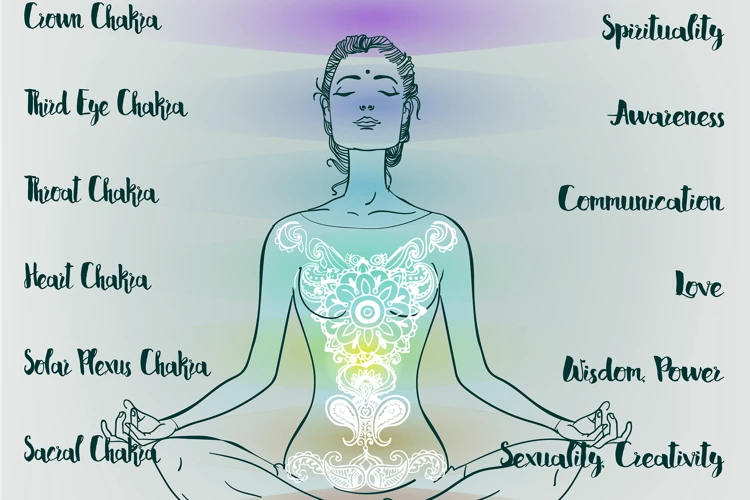
When it comes to spirituality, there are a multitude of approaches, practices, and beliefs. It can be overwhelming to navigate through them all, especially when trying to understand the role that chakras play in spiritual growth. These energy centers within the body have been studied and revered for thousands of years, yet their significance in spiritual development is still somewhat of a mystery. However, as we delve deeper into the world of chakras and spirituality, we begin to uncover some fascinating connections and insights that can help us in our own personal journey towards greater self-awareness and enlightenment.
Role in Spiritual Growth
Chakras play an integral role in spiritual growth, as they are believed to be the gateways to accessing higher levels of consciousness. Each chakra is associated with specific qualities and characteristics that can be developed through meditation and other spiritual practices. Understanding the role of each chakra and working to balance and align them can help individuals on their spiritual journey.
Chakra | Role in spiritual growth
— | —
Root chakra | The root chakra is associated with grounding, stability, and survival. Achieving balance in this chakra can help individuals feel more connected to their physical body and the earth, allowing for a strong foundation for spiritual growth.
Sacral chakra | The sacral chakra is associated with creativity, pleasure, and sexuality. Working with this chakra can help individuals connect with their creative energy and harness it for spiritual development.
Solar plexus chakra | The solar plexus chakra is associated with personal power and self-confidence. Developing this chakra can help individuals cultivate a sense of inner strength and courage, allowing them to take risks and pursue their spiritual goals.
Heart chakra | The heart chakra is associated with love, compassion, and forgiveness. Cultivating this chakra can help individuals connect with their emotions and develop a deeper sense of empathy and understanding for others.
Throat chakra | The throat chakra is associated with self-expression and communication. Balancing this chakra can help individuals speak their truth and express themselves authentically, leading to greater spiritual authenticity.
Third eye chakra | The third eye chakra is associated with intuition, inner wisdom, and spiritual insight. Developing this chakra can help individuals access higher levels of consciousness and connect with their intuitive abilities.
Crown chakra | The crown chakra is associated with spiritual connection and transcendence. Awakening this chakra can help individuals connect with the divine and experience a sense of oneness with the universe.
Working with chakras can be a powerful tool for spiritual growth and self-discovery. By understanding the role of each chakra and working to balance and align them, individuals can access higher levels of consciousness and tap into their full potential.
Alignment and Balance
The concept of alignment and balance is central to the practice of Kundalini and chakras. When the chakras are in balance and aligned, energy flows freely throughout the body, and one can experience a greater sense of peace, clarity, and connection.
Alignment refers to the positioning of the chakras along the central energy channel of the body, known as the sushumna. It is believed that the chakras should be aligned with each other and with the sushumna, so that energy can flow freely through the body.
Balance, on the other hand, refers to the state of each individual chakra. Each chakra is associated with different aspects of our physical, emotional, and spiritual selves, and when they are in balance, we experience a sense of wholeness and well-being.
To achieve alignment and balance, there are numerous practices that can be employed, including meditation, yoga, breathwork, and mantras. Each of these practices can help to bring the chakras into balance and facilitate the flow of energy throughout the body.
Another aspect of alignment and balance is the connection between the chakras and the elements. Each chakra is associated with a specific element, and when these elements are in balance, our physical and emotional health can be restored. This is why many Kundalini and chakra practices incorporate visualization and breathwork to help balance the elements and promote overall well-being.
Below is a table of the seven chakras, their associated elements, and the areas of the body that they are connected to:
| Chakra Name | Element | Physical Association |
| — | — | — |
| Root | Earth | Legs, feet, and base of spine |
| Sacral | Water | Reproductive organs, lower abdomen |
| Solar Plexus | Fire | Stomach, digestive system |
| Heart | Air | Heart, lungs, circulatory system |
| Throat | Ether | Throat, neck, shoulders |
| Third Eye | Mind | Brain, nervous system |
| Crown | Spirit | Upper skull, connection to the divine |
By understanding the elements associated with each chakra, and the physical areas that they are connected to, we can begin to work towards alignment and balance within our own bodies. Kundalini and chakra practices can be powerful tools for achieving a greater sense of well-being, and can lead to transformative experiences that have the potential to change our lives for the better.
Benefits of Kundalini and Chakra work
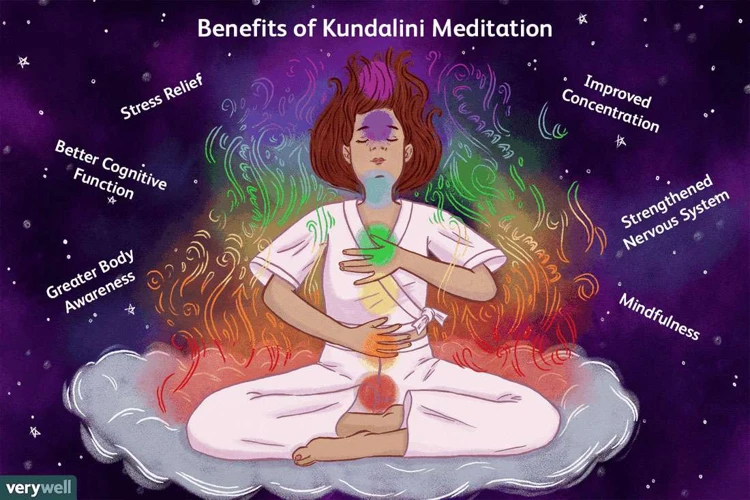
Unlocking the power within through Kundalini and Chakra practices can offer a multitude of benefits for the mind, body, and spirit. By activating and balancing the Chakras, Kundalini energy can flow freely throughout the body, producing both physical and emotional benefits. In this section, we will explore the myriad of benefits that can be experienced when incorporating Kundalini and Chakra work into one’s daily routine, including physical benefits such as improved sleep and digestion, as well as mental and emotional benefits such as reduced stress, heightened creativity, and spiritual growth.
Physical Benefits
When it comes to the physical benefits of Kundalini and Chakra work, the list is extensive. Here are some of the key ways in which these practices can positively impact the body:
- Improves overall health: Kundalini and Chakra work can help to strengthen the immune system, balance hormone levels, and reduce inflammation throughout the body. This can lead to improved overall health and a greater sense of vitality.
- Boosts energy levels: As the energy within the body begins to flow more freely through the Chakras, individuals often experience an increase in energy levels and a decrease in fatigue or lethargy.
- Enhances physical strength and flexibility: Certain postures in Kundalini Yoga can help to improve strength and flexibility in the body, leading to reduced risk of injury and an overall better physical performance.
- Improves digestion: The practice of Kundalini Yoga and Chakra work can help to stimulate the digestive system and promote healthy bowel movements, leading to better digestive health and reduced discomfort related to digestion.
- Reduces chronic pain: Kundalini and Chakra work can help to reduce chronic pain in the body, such as headaches or lower back pain, by removing blockages and promoting healthy energy flow.
- Enhances cardiovascular health: Kundalini and Chakra work can help to improve blood circulation and lower blood pressure, leading to better cardiovascular health.
- Improves sleep: By promoting relaxation and reducing stress, Kundalini and Chakra work can help individuals to achieve better quality sleep and wake up feeling more refreshed.
The physical benefits of Kundalini and Chakra work can have a profound impact on an individual’s well-being and overall quality of life.
Mental and Emotional Benefits
One of the most significant benefits of Kundalini and chakra work is the positive impact they can have on an individual’s mental and emotional well-being. Here are some of the ways these practices can help:
- Stress relief: Kundalini Yoga and chakra work can help reduce stress and anxiety by promoting relaxation and deep breathing. Regular practice can improve the body’s ability to respond to stressors, leading to greater emotional stability.
- Improved mood: Kundalini and chakra work may also help with depression by increasing serotonin levels and stimulating the endocrine system. As a result, the practice can lead to a more positive outlook and better overall mood.
- Greater self-awareness: Kundalini and chakra work can help individuals become more in tune with their thoughts, feelings, and behaviors. This awareness can lead to greater self-care, better decision-making, and more fulfilling relationships.
- Enhanced creativity: Kundalini and chakra work can stimulate the right hemisphere of the brain, which is associated with creativity and intuition. Regular practice can lead to greater creativity and a more expansive mindset.
- Improved relationships: As individuals become more self-aware and emotionally stable, they may also become better communicators and more empathetic. This can lead to greater intimacy and deeper connections in all types of relationships.
Kundalini and chakra work can have profound effects on an individual’s mental and emotional health. By reducing stress, improving mood, increasing self-awareness, enhancing creativity, and improving relationships, these practices offer a powerful tool for improving overall well-being.
Kundalini and Chakra Practices
When it comes to unlocking the power within through Kundalini and Chakra work, various practices can aid in this process. These practices include meditation, yoga, breathwork, and mantras, each of which can enhance one’s physical and mental well-being. In this section, we will delve into the different ways in which these practices can activate and balance the chakras and Kundalini energy, ultimately leading to a greater sense of harmony and inner peace.
Meditation and Yoga
When it comes to unlocking the power within through Kundalini and chakra work, meditation and yoga are powerful tools that can be incredibly beneficial.
Meditation: This practice involves focusing your mind on a certain object, thought, or activity to achieve a mentally clear and emotionally calm state. When done consistently, meditation has been shown to improve concentration, reduce stress and anxiety, and even lower blood pressure. There are many different types of meditation, including guided meditation, breath awareness meditation, and loving-kindness meditation. It’s important to find a type of meditation that works for you and to practice it regularly to reap its benefits.
Yoga: This physical practice helps bring balance and harmony to the body, mind, and spirit. Yoga has numerous physical benefits such as increasing flexibility, building strength, improving posture, and reducing inflammation. It also has mental and emotional benefits such as reducing anxiety and depression, and increasing overall well-being. There are many different types of yoga, including Hatha, Vinyasa, and Kundalini Yoga. Each type offers unique benefits, so it’s important to try different styles and find the one that best suits your needs.
Combining meditation and yoga offers a powerful way to unlock the power within. Many yoga classes incorporate meditation, and there are also specific types of yoga such as Kundalini Yoga that focus on both. Whether you choose to practice meditation and yoga separately or together, consistent practice can lead to profound changes in your life.
Breathwork and Mantras
When it comes to unlocking the power within and gaining control over our chakras, breathwork and mantras are two incredibly powerful practices that can help us achieve our goals. Here’s how:
Breathwork: Our breath is intimately connected to both our physical and emotional states. By practicing techniques that involve breath control, we can bring balance to our chakras and achieve a greater sense of peace and harmony.
There are many different breathwork techniques that can be used to activate and balance the chakras. Some of the most popular include alternate nostril breathing, deep belly breathing, and breath of fire. Each of these techniques targets different aspects of our physical and energetic bodies, allowing us to cleanse, revitalize, and balance our chakras.
Mantras: A mantra is a powerful tool for focusing our minds and achieving greater clarity and inner peace. By repeating a specific sound or phrase, we can tap into the energy of the universe and activate our chakras in a profound way.
There are countless mantras to choose from, each with its own unique vibration and energy. Whether we’re repeating mantra silently in our minds, chanting aloud, or listening to a recording, the effects can be transformative.
Incorporating breathwork and mantras into our daily practice is an excellent way to begin unlocking the power within and achieving a greater sense of balance and alignment. Whether we’re working to heal a specific chakra or simply seeking greater spiritual growth and understanding, these practices can be invaluable tools on our journey.
Conclusion
In conclusion, understanding the power of Kundalini and Chakras is a fascinating subject that has gained popularity in recent times. The knowledge of these energy centers and how to activate them is an ancient practice that has been passed down generations.
Through the understanding of the 7 Chakras and their respective functions, one can gain a deeper sense of self-awareness and attunement to their physical and emotional states. Furthermore, the awakening of Kundalini, a powerful serpent-like energy, provides one with a portal to greater spiritual heights.
However, it is important to note that the activation of Kundalini and working with the Chakras can have both positive and negative effects. It is therefore essential to conduct thorough research and seek guidance from experienced practitioners before diving into these practices.
Science is beginning to show us the validity of these energy centers through the study of the brain and nervous system, and the flow of energy throughout the body. Thus, Kundalini and Chakra work can have numerous physical, emotional, and spiritual benefits.
If one decides to embark on this journey, there are various practices to consider, such as meditation, yoga, breathwork, and mantras, each with their unique benefits.
Overall, the unlocking of the power within through Kundalini and Chakra work provides a fascinating and rewarding path for those seeking a deeper understanding of themselves and their connection to the world around them.
Frequently Asked Questions
What are some common signs of a Kundalini awakening?
Some common signs include strong sensations in the body, emotional changes, heightened spiritual experiences, and altered states of consciousness.
Is it possible to force a Kundalini awakening?
No, attempting to force a Kundalini awakening can be dangerous and should only be attempted under the guidance of an experienced teacher.
How can I prepare for a Kundalini awakening?
Preparation can involve practices such as yoga, meditation, and energy work, as well as developing emotional and mental stability.
Are chakras real or just a metaphor?
While there is no scientific evidence for chakras, many cultures and belief systems acknowledge their existence and incorporate them into their healing practices.
What can blockages in the chakras lead to?
Blockages in the chakras can lead to physical, emotional, and mental imbalances, as well as a sense of disconnection from oneself and others.
Can Kundalini awakening lead to mental health issues?
In some cases, a Kundalini awakening can cause psychological disturbances. This is why it’s important to approach Kundalini awakening with caution and under the guidance of a qualified teacher.
What is the relationship between Kundalini and sexuality?
Kundalini energy is said to reside at the base of the spine, near the area associated with sexuality. Some Kundalini practices involve channeling this energy to enhance sexual experiences.
Are there any risks associated with Kundalini practices?
Yes, there are risks involved in practicing Kundalini techniques, such as physical injuries, emotional upheaval, and psychological disturbances. These risks can be minimized by preparing properly and working with an experienced teacher.
Can Kundalini awakenings happen spontaneously?
Yes, some people report having spontaneous Kundalini awakenings without any prior preparation or intentional practice.
Can I experience the benefits of Kundalini and chakra work without a full awakening?
Absolutely! Even without a full awakening, practices such as meditation, yoga, and breathwork focused on the chakras can lead to many physical, mental, and emotional benefits.

